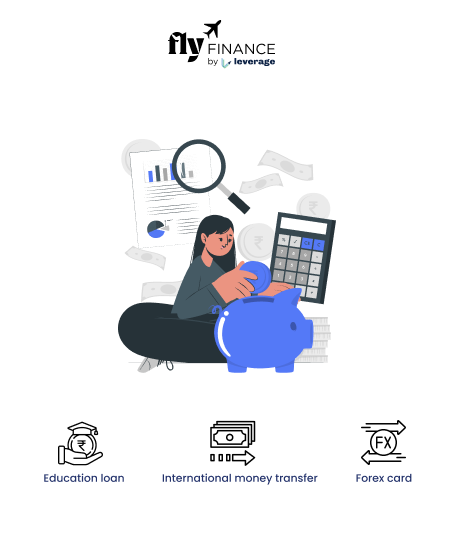Are you trying to figure out the best way to transfer money overseas? Whether you’re sending funds for tuition fees, living expenses, or supporting family abroad, choosing the right method can be confusing. One popular and trusted method is the SWIFT wire transfer. But what is it, and why does it matter?
To know about what exactly SWIFT money transfer is, there are a few important things to know, like how it works, its fee, and the challenges that come with it. To get a better understanding of the SWIFT wire transfer, we urge you to read this blog till the very end.
Table of contents
- What is a SWIFT Wire Transfer?
- What is the SWIFT Code?
- How Does a SWIFT Wire Transfer Work?
- Why Do Use SWIFT Transfers?
- Duration of a SWIFT Wire Transfer
- How Much Does a SWIFT Wire Transfer Cost?
- Who Uses the SWIFT System?
- Additional Services with SWIFT
- Challenges of SWIFT Wire Transfer
- Tips for Indian Students Using SWIFT
- FAQs on SWIFT Wire Transfer
What is a SWIFT Wire Transfer?
A SWIFT wire transfer is a secure way to send money across borders using the Society for Worldwide Interbank Financial Telecommunication (SWIFT) network. This global system connects over 11,000 banks and financial institutions, making it a trusted choice for international money transfers. Whether you’re paying for a course in the UK or sending funds to family abroad, SWIFT ensures your money reaches the right place.
Every bank in the SWIFT network has a unique code, called a SWIFT code. Think of it as an address that tells the system exactly where your money needs to go. Along with the SWIFT code, you’ll need the recipient’s account number and personal details to complete the transfer.
Also Read: LATEST TCS ON FOREIGN REMITTANCE FOR EDUCATION SECTION
What is the SWIFT Code?
A SWIFT code is a common international money transfer terms, also known as a BIC (Bank Identifier Code), plays an important role in the wire transfer process. It helps identify the bank and its location. A SWIFT code usually has 8 or 11 characters.
Let’s take an example of a SWIFT code from HDFC Bank: HDFCINBB
Here’s what each part means:
- HDFC – The first four letters are the bank code.
- IN – The next two letters represent the country code (India).
- BB – These two letters are the location or city code.
- (Optional 3 characters) – If present, the last three characters identify a specific branch.
How Does a SWIFT Wire Transfer Work?
SWIFT is a secure network used by banks and financial institutions to help people and businesses send money across countries. SWIFT wire transfer works behind the scenes to make international money transfers happen. Let’s say you’re an Indian student sending money to a university in the UK. Here’s what you need to do:
- Gather the Details: You’ll need:
- Recipient’s Full Name: Who’s getting the cash?
- SWIFT Code: Their bank’s SWIFT code a unique ID.
- Account Number: Where the money goes.
- Amount: How much you’re sending.
- Visit Your Bank: Log into your bank’s online banking app or website. Most Indian banks, like HDFC, ICICI, or SBI, offer this service.
- Add the Recipient: Enter the recipient’s details, including the SWIFT code. Some banks, like HDFC, may take 30 minutes to verify and register the recipient.
- Start the Transfer: Select the “Foreign Outward Remittance” or “International Transfer” option, fill in the amount, and confirm the transaction. You might need to enter an OTP (one-time password) sent to your phone.
- SWIFT Steps In: Your bank sends a secure message via the SWIFT network to the recipient’s bank with transfer instructions.
- Money Moves: If the banks know each other, the transfer is direct. If not, an intermediary bank helps out, passing the funds along.
- Wait for It to Process: The money usually takes 2-5 business days to reach the recipient’s account.
Also Read: Difference between EFT and Bank Wire Transfer
Why Do Use SWIFT Transfers?
There are various benefits of wire transfer and as an Indian, you might need to do SWIFT Transfers in order to send money abroad for various reasons, such as:
- Students: Paying overseas fees or expenses.
- Families: Sending money to relatives abroad.
- Businesses: Handling global trade or supplier payments.
- Banks and Brokers: Moving funds securely.
The Reserve Bank of India (RBI) allows these transfers under specific purposes, like education, travel, or family support. Just make sure your bank account is linked to your PAN card to avoid delays.
Duration of a SWIFT Wire Transfer
A SWIFT wire transfer usually takes 2-5 business days. The exact time depends on the countries involved and how quickly the banks process it. Double-check all details—like the SWIFT code and account number—because mistakes can delay or cancel your transfer.
How Much Does a SWIFT Wire Transfer Cost?
The cost of a SWIFT transfer depends on your bank. Here’s a quick look at fees charged by some popular Indian banks for SWIFT wire transfer:
| Name of the Bank | SWIFT Wire Transfer Fee |
| HDFC Bank | INR 500 |
| SBI | INR 960 (Around USD 11.25) |
| ICICI Bank | INR 750 |
| Kotak Bank | INR 500 |
| Axis Bank | INR 500 |
These fees can change, and some banks might charge extra if you visit a branch instead of using online banking. Also, watch out for exchange rate charges—banks often add a small markup to the currency conversion rate, which acts like a hidden fee.
Also Read: HOW TO DO MONEY TRANSFER FROM USA TO INDIA?
Who Uses the SWIFT System?
From students to large businesses, SWIFT helps millions transfer money across the globe through secure wire transfers. The SWIFT system offers its services to the following users:
- Banks
- Depositories
- Brokerages
- Corporate Businesses
- Exchanges
- Dealers of Securities
- Asset management companies
- Individuals sending money transfers internationally
- Treasury market participants and service providers
Additional Services with SWIFT
The SWIFT Wire Transfer system isn’t just about sending money abroad—it offers a range of tools to make international transactions smooth and smart. Curious about what else it can do? Let’s explore some standout services that go beyond basic transfers.
1. Industry-leading Applications
With SWIFT, you get access to powerful tools that handle everything from instant payment matching to foreign exchange and treasury tasks.
These tools help with:
- Connecting banks for smooth payment processing.
- Managing securities clearing and settlement steps.
- Handling instructions for securities, forex, and derivatives deals.
2. Business Intelligence
SWIFT provides easy-to-use dashboards and reports that give you a full picture of your transactions. You can track messaging, activity, and trade flows in real time. Plus, filter data by region, country, or message type—perfect for staying on top of your finances!
3. Compliance Services
Worried about financial rules? SWIFT has your back with services for tackling financial crime. It offers tools for Know Your Customer (KYC) checks, Anti-Money Laundering (AML) efforts, and managing sanctions—keeping your transfers safe and legal.
4. Messaging and Connectivity
SWIFT shines when it comes to communication. Its main job? Moving messages between banks securely and reliably. With messaging hubs and software, you can send and receive global payment instructions without breaking a sweat.
5. Global Payment Innovations
Meet SWIFT Global Payments Innovation (GPI)—the latest game-changer! SWIFT wire transfer makes cross-border payments easier to track and more transparent. If your bank uses SWIFT GPI, you can check your payment’s status anytime, anywhere—something no other system matches.
Challenges of SWIFT Wire Transfer
SWIFT is reliable, but it does have some drawbacks—especially for frequent or high-volume international transfers. One key issue is that processing many transactions manually can lead to delays and errors. While automation is helping improve this, it may also increase costs.
Here are some common challenges:
- Automation Costs: Upgrading systems can raise operational expenses, which may impact customers too.
- Speed: Transfers can take 2–5 business days, slower than other online services.
- Cost: Fees and exchange rate margins can make transfers expensive.
- Manual Processing: Some transactions still require manual handling, increasing the chance of mistakes.
Tips for Indian Students Using SWIFT
Want your SWIFT wire transfer to go off without a glitch? These practical tips, tailored for you to save you time and money. Master the process with ease!
- Verify Details: Wrong SWIFT codes mean delays.
- Check RBI Rules: Education transfers are allowed up to $25,000 per transaction.
- Compare Costs: Ask your bank about fees and rates upfront.
- Track It: Use your bank’s app to monitor progress.
A SWIFT wire transfer is a solid choice for sending money abroad, especially for Indian students managing international payments. It’s secure and widely used, but the fees and wait time might push you to explore other options for smaller amounts. Whether you’re funding your studies in Canada or supporting family in Australia, understanding SWIFT helps you save time and money.
FAQs on SWIFT Wire Transfer
SWIFT stands for Society for Worldwide Interbank Financial Telecommunication—a global network connecting over 11,000 banks. SWIFT wire transfer doesn’t move money itself but sends secure messages between banks to process your transfer. You provide details, your bank debits your account, and SWIFT ensures the funds reach the right place!
A SWIFT wire transfer usually takes 2-5 business days to complete. The time depends on the countries involved, bank processing speeds, and whether an intermediary bank is needed. Double-check your details to avoid delays!
No, not all banks use SWIFT. Many smaller banks are not a part of the SWIFT network.
To get a SWIFT code, ask the recipient (like a friend or university) for their bank’s unique code—it’s 8 or 11 characters long. You can also find it on the bank’s website or by contacting their customer service. For example, HDFC Bank’s SWIFT code is HDFCINBB.
Log into your bank’s app or website (e.g., HDFC or SBI), go to the international transfer section, and enter the recipient’s name, their bank’s SWIFT code, and account number. Add the amount, confirm with an OTP, and you’re done—your bank handles the rest!
A SWIFT code is an 8-11 character ID that identifies a specific bank, like HDFCINBB for HDFC Bank. You can get it from the recipient—ask them to check with their bank or look online. It’s crucial for ensuring your money lands in the right account!
Fees depend on your bank—HDFC and Axis charge INR 500, ICICI INR 750, and SBI around INR 950. Extra costs like exchange rate markups (1-3%) or intermediary fees (USD 10-USD 30) might apply too. Always ask your bank for the total cost before sending!
Yes, SWIFT is great for paying overseas university fees, and it’s allowed by the RBI for education purposes. You can send up to USD 25,000 per transaction, perfect for tuition or living costs. Just ensure you have the university’s SWIFT code and account details handy.
You’ll need the recipient’s full name, their bank’s SWIFT code, and their account number. Don’t forget the amount you want to send, in rupees or the foreign currency. Missing or wrong info can delay your transfer, so verify everything!
Many Indian banks, like HDFC or SBI, let you track your transfer via their app or customer care. You’ll get updates on when the money leaves and arrives at its destination. It’s a handy way to stay stress-free during the process!
Closing on this detailed guide on SWIFT wire transfer, this blog sheds light on the increasing prevalence of international money transfers. You can reach out to Fly Finance for any finance-related queries, including the transfer of money, for study abroad purposes.





























